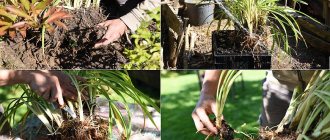Author: Natalya Category: Garden plants Published: January 18, 2019Republished: February 19, 2019Last edits: November 03, 2020
- How to care for autumn
- When to replant
- Growing from seeds
- Preparing for winter
- Non-double
What is the favorite flower of Hollywood stars Gwyneth Paltrow and Drew Barrymore? That's right: peony. This flower has been admired for thousands of years, but its popularity does not fade. When Marco Polo first saw the peony, he described it as a flower “the size of a cabbage”: flowers of some varieties can reach 25 cm in diameter. Peonies grow in almost every garden, and we eagerly await the beginning of their flowering, when the air is filled with a magical aroma , and bright caps of flowers will appear on the bushes...
- What varieties of peonies are there?
- When and how to plant a peony in the garden?
- How to care for a peony during the season?
- How to prepare a bush for wintering?
You will get answers to these and other questions in our article.
Planting and caring for peonies
- Planting: late August or early September.
- Flowering: May.
- Lighting: bright sunlight in the first half of the day, then bright diffused light or light partial shade.
- Soil: slightly acidic loam.
- Watering: infrequent, but plentiful: 2-3 buckets of water for each adult bush.
- Feeding: the first feeding is carried out in early spring, and from the second week of May, peonies are treated with a solution of mineral or organic fertilizer every month, leaves at a time.
- Reproduction: root cuttings and seeds (rarely).
- Pests: bronze beetles, turf ants, root-knot nematodes.
- Diseases: gray rot, rust, brown spot, septoria, root rot, viral mosaic.
Read more about growing peonies below.
flower (lat. Paeonia) is a monotypic genus of herbaceous perennials, the only one in the Peony family. There are herbaceous types of peonies, tree peonies, and also types that combine the properties of both tree and herbaceous peonies - about forty species in total. In nature, peony flowers grow in the temperate and subtropical zones of North America and Eurasia. Cultural cultivation of peonies began in China during the Han era, more than two thousand years ago. The peony flower is named after the legendary healer Pean, who saved both gods and people from mortal wounds received in battles. In our gardens, we mainly grow herbaceous peony, highly valued by gardeners for the beautiful fragrant buds that decorate the flowerbed from May for a month and a half. Our story will be about these peonies.
How did peonies appear?
Peonies gained fame several centuries before the new era in Greece, China, and Rome, not only as an ornamental, but also a medicinal plant.
The peony enjoyed enormous popularity in China in the 1st century AD. peony was actively used in folk medicine and cooking.
Peony is a favorite flower among the Chinese; it is a symbol of long-lasting love. In almost all Chinese legends, the spirit of the peony is a beautiful girl.
In India, Iran and Pakistan, the peony is considered a symbol of pride. In China, the peony represents the Yang principle - masculinity, light, love, luck, wealth, spring, youth, happiness and longevity, in Japan - a symbol of well-being and prosperity! Among eastern peoples, peony means “bashfulness” and “shyness.”
More than 30 varieties of peonies were known in China; especially rare ones were valued very expensively and were exchanged only for gold.
The name peony (Paeonia) comes from a Greek myth. The student of the healer Asclepius was called Paeon.
Legend has it that with the help of an unknown plant he performed amazing healings, even curing the god of the underworld Hades from the wounds inflicted on him by Hercules.
Peon received this plant from the hands of Apollo’s mother, the goddess of darkness Summer. The miraculous healing aroused envy in Asclepius, and he ordered the secret killing of Peon.
Hades, in gratitude, did not allow him to die, turning him into a beautiful flower, which since then bears his name and has beauty and healing properties.
Peonies are perennial plants; they form a bush that will decorate any garden plot.
If you have an empty plot, then peonies will wonderfully decorate it; plant them in groups.
Wherever you plant a peony, it will attract attention and become the main decoration.
Peony sits beautifully next to irises, bells, poppies, blue sage, asters and chrysanthemums.
Peonies are very light-loving, so experts recommend planting them in sunny places, and the planting site should be well protected from winds and sharp drafts.
It is worth noting that it is better to buy peonies in early autumn; to select a healthy plant, there must be at least 3 buds on the tuber root.
Botanical description
Peonies are herbaceous, semi-shrub (tree peonies) or shrubby plants, reaching a height of 1 m. The rhizome is large, the roots are cone-shaped, powerful. There are several stems, trifoliate or unpaired pinnate leaves of all shades of green, glaucous or dark purple are arranged alternately along the stems. Peony flowers are single, fragrant, reaching 15-20 cm in diameter; they are good both on the bush and as a cut flower. Peony is unpretentious, its agricultural technology is not difficult, so it has always been valued by flower growers: even when the flowers fade, peony bushes with openwork lush foliage remain attractive until autumn.
- Brugmansia: growing in the garden, types and varieties
Peonies are long-lived; they can grow in one place for decades.
Breeders also showed interest in this garden plant, and to date, over five thousand varieties of peonies have been registered, bred mainly with the participation of species such as peony lactiflora and peony officinalis. Varieties of peonies differ in the color of the flowers, their size, flowering time, outline and height of the bush.
Herbaceous peony, its reproduction
Peonies reproduce vegetatively: by dividing root tubers, renewal buds, green and root cuttings, layering.
Bushes are divided starting from six to eight years of age.
Younger bushes have small rhizomes and are difficult to divide.
Dividing begins in the second half of August before the formation of fresh adventitious roots, which are easily damaged during transplantation.
Peonies dug up and cleared of soil are left in the air for several hours.
During this time they will wilt a little and will not be too fragile.
Before dividing, the stems are cut to a height of 8-10 cm from the ground.
They inspect the bush, choose a place with the fewest buds, drive a strong wooden stake there and use it to tear the bush into two parts.
Next, each part is divided into standard plots with a garden knife.
A standard plot is a part of a root tuber at least 10 cm long with three or more large buds.
Thick, long-rooted tubers are cut to 12-20 cm at an angle from the inside.
Old, diseased, rotten parts of the tuber roots are removed or trimmed to healthy white tissue.
When dividing, you need to preserve the small young roots that grow from the rhizome.
During all operations, the roots of the tubers should not be held by the cuttings of the stems, since they easily break off and there are buds at their base.
When dividing bushes, a certain number of buds usually fall off. They are immediately planted on a bed according to a 20x10 cm pattern and to a depth of 1 cm from the top of the bud.
In the first year for the winter, it is better to cover it with a layer of 15-20 cm of peat. By August of next year, this plant is not inferior to a standard plot.
Such plants bloom in two to three years.
Planting peonies
How to plant
Growing peonies will not require a lot of time or excessive effort from you. The most important thing is to choose the right area for peonies, because they will grow there for many years. The root system of adult plants reaches a depth of 70-90 cm, so replanting a bush that has reached 4-5 years of age is not an easy task. Peonies prefer to grow in well-lit areas; sunlight for 5-6 hours in the morning is highly desirable. But peonies are afraid of drafts, so it would be nice if they were protected by tall bushes or trees.
Do not plant peonies in low areas: the rhizomes can rot from stagnant water.
In the photo: Growing peonies in a flower bed
As for the choice of soil, loam with an acidity of 6-6.6 pH is best suited for peonies. If the soil is too clayey, you will need to add humus, sand and peat. In sandy - peat, clay and humus. Sand, wood ash and organic matter are added to peat soils.
Autumn planting
Peonies are planted and replanted in late August - early September. A week before planting peonies, they dig holes measuring 60x60x60 cm at a distance of 70-100 m from each other; a drainage layer of 20-25 cm of coarse sand, broken brick or crushed stone must be laid at the bottom of the holes. Then a layer of top dressing consisting of compost, humus, 100 g of lime, 200 g of superphosphate, 100 g of potassium sulfate, 300 g of wood ash is poured in a layer of 20-30 cm. Then the holes are filled to the top with earth mixed with compost. In a week, by the time the peonies are planted, the soil in the hole will have subsided, which will make it possible to place the peony rhizome in the hole, sprinkle it with garden soil and lightly compact the soil.
Keep in mind that peonies do not tolerate deep planting: the result will be a dense green bush without flowers.
If you want to wait for lush flowering from peonies, deepen the rhizome so that the upper bud is no deeper underground than 3-4 cm. In addition, in the first year after planting or transplanting, peonies do not bloom and look lethargic. It happens that peonies will not bloom the next year, but this is not a problem if the bush looks healthy - it’s just that the peony bush has not yet reached maturity.
In the photo: Peony bud
Planting in spring
Actually, peonies are not planted in the spring. But it happens that in the spring you received the planting material you dreamed of... and what to do? In this case, experts suggest planting peonies in a 2-3-liter pot and keeping them in a cool, dark room - a basement or cellar - until planting them in the ground, keeping the soil moist. To do this, you need to place snow or pieces of ice on top of the soil, which, when melted, will moisten the soil in the pot. At the end of April or May, the peony is taken out into the garden and buried in the ground directly with the pot, where it will remain until the autumn transplant into a prepared hole, carried out by transshipment, that is, together with the earthen lump in which the rhizome was located.
When to plant peonies in autumn and spring: optimal timing
It is necessary to plant the plant during the period when the suction roots are growing. Plants planted during this period take root and grow more successfully.
Planting time in spring
The optimal time for planting in the spring - the moment the roots grow, usually occurs in April and May, so it is advisable to carry out the procedure at this time.
Planting dates in autumn
When is the best time to plant peonies in the fall? It is necessary to choose a period so that 3-4 weeks remain before the first frost . During this time, the plant will have time to take root and its roots will grow. Otherwise, if the procedure is too late, the plant will not have time to take root, which can result in weakening of the plant, lack of flowering, development of diseases and even death.
The optimal timing for planting peonies in the fall differs in different regions:
- In the middle zone (Moscow region) - all September;
- In Siberia, the Urals, the North-West (Leningrad region) - the end of August and the first half of September;
- In the South (Krasnodar Territory (Kuban), Northern Caucasus) - end of September, first half of October.
You can also choose the optimal timing for planting a peony in the fall according to the 2021 Lunar calendar:
- Favorable days: in August - 6, 7, 20, 21, 23, 24, 25, 27, 28, 29, 30;
- in September - 9, 10, 11, 15, 16, 19, 20, 21, 26;
- in October - 6, 7, 8, 21, 22, 23;
- in November - 9, 10, 11, 12, 13, 23, 24, 27, 28.
- in August - 4, 5, 19, 31;
What to do if you were unable to plant peonies in the fall at the right time
It is not always possible to bring plans to life in the required time frame. A situation may also arise that you did not have time to plant a peony in the fall at the optimal time, for example, certain circumstances arose, there was a lot to do, or you were unable to get a seedling on time. You can successfully plant late in the fall (in October, November) if you follow a certain technology:
- You need to plant the seedling in a pot and move it to a greenhouse or loggia, but it is required that this room maintain a positive temperature. In such conditions, the plant will have time to take root.
- After about two weeks and after the temperature drops to 0 or below, the division should be planted in open ground directly in a pot in late autumn.
- Next year, in the fall, dig up a pot and transplant the plant to a permanent place in the ground.
Video: late planting of peonies in autumn.
Caring for peonies
How to care for autumn
In autumn, as already mentioned, it is time to plant and replant peonies. Peonies are not planted every year, and if you have no plans to propagate them this year, caring for peonies in the autumn comes down to trimming withered stems and leaves, which then need to be burned to destroy viruses, bacteria and pests that may , they settled in them. The remaining stems on the bushes should be sprinkled with ash at the rate of 2-3 handfuls per bush. That's all there is to do in the fall. Now we’ll tell you how to care for peonies in the spring.
In the photo: Blooming pink and white peonies
Spring care
Peonies require infrequent but plentiful watering - 2-3 buckets for each adult bush, so that the soil is wet to the depth of the roots. Plants especially need moisture in early spring, during the growth period, as well as during budding and flowering, and in August-September, when new buds are formed in peonies. After watering, it is imperative to loosen the soil around the bushes and remove weeds, if any. Make sure that when watering the water gets under the bush and not on the leaves.
Top dressing
As soon as the snow melts, the ground around the bushes is watered with a solution of potassium permanganate at the rate of 2-3 g per 10 liters of water for two peony bushes. When the shoots begin to grow, you need to fertilize the plants with ammonium nitrate at the rate of 15 g of nitrate per 10 liters of water. Starting from the second week of May, young plants are watered once a month over the leaves from a watering can with a sieve with a solution of complete mineral fertilizer in the recommended concentration. Add washing powder to the solution at the rate of 1 tablespoon per 10 liters of water - this will prevent the solution from simply flowing down the leaves into the ground. Feeding is done in the evening or on a cloudy day.
How to grow hydrangea from cuttings - instructions
- How to care for lilies of the valley in the ground
During the period of budding and flowering, it is necessary to mineralize the soil with the following solution: 10 g of superphosphate, 7.5 g of ammonium nitrate, 5 g of potassium salt per 10 liters of water. Two weeks after the end of flowering, you need to feed the peonies with a solution of 10 g of superphosphate and 5 g of potassium salt per 10 liters of water. You can alternate mineral fertilizers with organic ones, and instead of a solution, scatter dry fertilizers in the furrow around the bush, followed by moistening and embedding into the soil.
In the photo: Opening peony bud
Caring for peonies in the summer , after the peonies have bloomed, consists of timely watering, fertilizing after flowering, weeding and loosening the area.
Trimming
When to prune peonies? Complete pruning of peony stems is done in late autumn, when frost sets in. But if there is a need to do this earlier, then try to cut the stems not too low, leaving shoots with three to four leaves above the surface of the ground. The fact is that at the end of summer, peonies lay replacement buds, and the success of this process directly depends on the presence of leaves on the bush. Therefore, by the way, when cutting flowers you need to follow this rule: cut the peduncle not very close to the root, leave a part of the stem with several leaves on the bush.
Feeding young peonies
There is a fairly common misconception that peonies do not need to be fed in the first couple of years after planting, since they supposedly have enough nutrients poured into the hole before planting. Experienced gardeners know that this conclusion has nothing to do with reality.
Since the roots of seedlings are partially cut off before planting, in the first years of life the new plant’s root system is still very weak and simply does not reach the nutritional reserves in the lower part of the hole. And while the roots grow to the hidden fertilizers, they need to get food somewhere, which is not enough in the upper layer of the flowerbed. So you have to think not only about where to plant peonies in the country, but also about how to fertilize them.
It is recommended to feed with mullein solution. In this case, fertilizer is applied into small holes around the bush. Thanks to these feedings, the root system will develop faster, which in turn will contribute to the normal formation of the above-ground parts of the plant - stems, leaves and buds. Instead of mullein, you can also use complex mineral fertilizer dissolved in water.
The optimal time for applying liquid fertilizers is the period between the appearance of the first shoots and up to July.
Transplanting peonies
When to replant
Wild peonies grow in one place for up to fifty years or even more. Hybrid varieties that originate from the officinalis peony can grow without replanting in the same area for no more than ten years; after this period, the bush must be divided and transplanted to another place. In addition, dividing and planting the bush is the easiest and most reliable way to propagate peonies. But for this purpose, 4-5 year old bushes are used, which have already fully bloomed once or twice. The fact is that the root system of peonies grows greatly over the years, so it is easier to cope with a younger rhizome than with an old one, so in order to ensure that the quality of flowering of your peonies does not decrease, it would be better to divide and plant the bushes every three to four years . Peonies are replanted in September.
In the photo: White peony flower
Autumn transplant
How to replant peonies? In autumn, the bush is dug at a distance of 25 cm from the rhizome, then carefully loosened with a pitchfork and removed from the ground. The rhizome is cleared of soil with a peg, then washed with a not very strong stream of water so as not to damage the fragile buds and eyes of the peonies. The above-ground part is cut off almost to the root. The washed rhizome is left in the fresh air so that the water drains and the roots slightly wither and become more elastic. Then the old thick roots are trimmed to a length of 10-15 cm at an angle of 45º.
Carefully examine the root and only then proceed with division.
If the bush is old, then it is most convenient to drive a wedge into its middle with a hammer, which will split the rhizome into several parts. Often in the middle of old rhizomes there are voids and rotten areas that need to be cleaned, disinfected with a strong solution of potassium permanganate, and then the sections are powdered with fungicide. The divisions should consist of part of the root collar with well-developed 3-4 eyes and several roots. You need to try to divide the rhizome into approximately equal parts, so that there are no too large sections that will hurt for a long time after transplantation, or too small ones that may die.
In the photo: Growing peonies in the garden
How to replant
You need to plant the cuttings in the ground using the method that has already been described. The area with transplanted plants must be mulched with a seven-centimeter layer of peat for the winter; the mulch can be removed when reddish peony sprouts break through it in the spring. During the first two years after transplanting, peonies must develop a root system, so be patient and do not let young plants bloom. In the first year, pinch off all the buds that appear, the next year, leave just one bud on the bush and, when it bursts, cut it as short as possible and consider how well the flower matches its variety. If the match is incomplete, then you will have to pinch off the buds for another year, leaving only one, until the flower fully matches its variety. This may happen in the third year, or maybe in the fifth.
Soil for peonies
Peonies are not so capricious in matters of soil composition and, in principle, can grow normally in most garden soils. However, cultivated loamy soil is best suited for these flowers - moisture-absorbing, but well-drained. Peonies require normally moist soil, but in no case damp and waterlogged, because then their root system rots. In general, the underground environment should be slightly alkaline (pH between 5.8 and 7, optimally 6.5).
Since the roots of peonies grow only in soft soil, in order for the root system of plants to reach normal sizes, the ground where you decide to plant a tree peony must be cultivated to its maximum depth. Otherwise, when dense layers of soil are reached, the roots will begin to grow to the sides. And if, as a result of this, the root system is formed in the upper, quickly drying layer of soil, the plants will grow poorly, and you can completely forget about normal flowering. On poor soils, deep tillage is also necessary because the soil will have to be thoroughly fertilized before planting peonies.
Peony propagation
Growing from seeds
You are already familiar with the vegetative propagation of peonies by dividing the bush. Peonies also reproduce in other ways, for example, by seed. But it should be remembered that peony seeds do not always retain varietal qualities, therefore, as a rule, only breeders use them. And plants grown from seeds bloom only in the fourth or fifth year. But if you want to try to develop a new variety, then sow freshly collected seeds in August directly into loose soil, and next spring they will germinate.
Rare ways to propagate roses
Propagation by root cuttings
This is the most reliable way to propagate peonies. A small piece of rhizome with a dormant bud is separated from the bush in July, planted, and by September it has already taken root. True, this method is not suitable for those who are in a hurry: such shoots develop slowly and will be able to bloom for the first time in five years.
Planting rules: location, soil, distance, depth
There is not always accurate and correct advice on planting flowers on the Internet.
Therefore, we have collected rules proven by many years of experience in growing peonies, not only by amateurs, but also by scientists who specialize in them in botanical gardens and nurseries throughout the former USSR.
Experts kindly shared their secrets of agricultural technology with us, and we supplement them with our own recommendations and share them with you.
We hope that now as many people as possible will be able to successfully plant peonies in their gardens. After all, these beautiful flowers bring amazing aesthetic pleasure and lift your spirits!
So, for the successful growth and development of a plant, several key factors need to be taken into account: place, soil, timing, planting hole, distance, planting depth and the seedling itself.
Peony planting site
The flower is very resilient, it can grow for several decades without replanting and bloom profusely every year. Therefore, you need to choose a place for it with all seriousness.
It should be well lit and warmed by the sun, protected from drafts. It is advisable that the sun illuminates the plant in the morning and evening, and slight shading during the peak of the heat will prolong its flowering. The best position is the eastern side, with morning sun and afternoon partial shade.
Categorical prohibition
- A humid place where there are even short-term stagnant waters (spring/autumn). Flooded roots will begin to rot and lead to the death of the flower.
- Shaded place. Shade is contraindicated for herbaceous and tree-like peonies; even if they are heavily shaded for 2-3 hours a day, they will begin to wither and you will have to forget about flowering.
- The distance from trees is closer than three meters, and large shrubs and houses are 1.5-2 m. The roots of a tree or shrub will take minerals from the ground, which will result in a lack of them for the flower. And the walls of the house emit heat and create a temperature difference.
The soil
Peonies grow great on soil with a neutral and slightly acidic reaction - pH 6.2-6.8. Therefore, check and normalize the acidity of the soil. Be aware that fertilizing with mineral fertilizers increases acidity, as does mulching with peat.
Tree and herbaceous species love loamy soil with a high level of moisture and air permeability. Add sand and compost to excessively clayey soil.
It is not recommended to plant in peat soil due to the high level of acidity. To reduce it, add wood ash, sand, humus and slaked lime. For more details, see step-by-step planting instructions.
We recommend reading:
- HOW TO CHECK THE ACIDITY OF THE SOIL?
Planting depth and distance
These are very important points that determine the future fate of the plant. Will it bloom profusely and develop well? How will it survive the winter? How effective will fertilizing be, and how often will it be necessary to fertilize?
At what distance are peonies planted?
The distance between peonies when planting is of great importance for their further development. Remember that it is better to retreat a little more than less.
| Peonies | Landing distance |
| Low-growing herbaceous varieties | Planting in a row - 70-80 cm. In other cases - 90-110 cm. |
| Vigorous herbaceous and tree varieties | 130-180 cm. |
At what depth should peonies be planted?
The depth of the upper bud on the rhizome is 3-4 cm (heavy soil) or 5-7 cm (light soil). The golden rule has been tested many times all over the world.
The correct planting depth of a peony lays the foundation for successful growth and development. The rhizome of the plant gradually grows upward, and during weeding the soil is sometimes raked away from the buds, they remain unprotected and suffer from heat or frost.
At the same time, planting too deep provides excellent development, but leads to a lack of flowering.
For convenience, you can put a board, pull a rope and navigate along it.
Adjusting the peony planting depth
Peonies after flowering
Peonies have faded - what to do? Peonies bloom in late May or early June. Remove all faded flowers, after two weeks, apply a third fertilizing with phosphorus and potassium fertilizers and continue to water the plants regularly. In August, watering should become more abundant, since the period of formation of replacement buds begins, and the plant will need moisture.
How and when to plant lilies - proven tips
Preparing for winter
When the leaves and stems of peonies begin to turn yellow, watering should be gradually reduced, and when frost sets in, the above-ground part of the bush should be cut back almost to soil level. If you replanted old peonies or planted new ones in the fall, you will have to cover this area with a layer of peat mulch of 5-7 cm so that the weak peonies after transplantation feel comfortable in winter. In the spring, when peonies sprout, the mulch layer can be removed.
- Zamanikha: cultivation, properties and contraindications
In the photo: Peony seeds
Peonies in winter
Peonies spend the winter in the garden. Old bushes are not afraid of frost, and if you have covered young peonies for the winter, you can rest assured that your flowers will not die.
How to prepare peonies for planting
A label with the name of the variety should be attached to the purchased cuttings. It is convenient to cut labels, for example, from metal coffee or beer cans. The name of the variety is extruded with a hard lead pencil or ballpoint pen. Such a label can be stored in the ground for several years and, when dug up, will help identify the variety.
Before planting herbaceous peonies, carefully inspect the rhizome. The delenka has protruding remains of stems; a label with the name of the variety is attached to these stems. This is a common case for domestically produced carcasses. When planting such a division, the remains of the stems will rot, and through them rot and infection will penetrate into the plant. The stems must be cut to the base of the root collar. Rub the cut areas with ash. Attach the label securely to the section.
A very wilted piece of wood. If the cutting is severely wilted, it is recommended to place it for several days in slightly moistened moss or damp sand, moistened with a slightly pink solution of potassium permanganate.
The delenka has a mass of more than 250-300 g. The roots are very long: more than 15-20 cm. Such large delenkas are often supplied abroad. When planted as a whole, such a plant develops externally faster in the first year after planting and often blooms in the second year. But this quick external effect is achieved due to the reserves in the root system of the division, and new roots develop weaker and complete renewal does not occur. In the future, such a plant may develop more slowly than from a division of normal size. For the long term, it is better to divide such a division into 2 parts (this is sometimes possible) or shorten the roots.
An exception to this rule are plants with a closed root system: such plants are carefully removed from the pot and transplanted entirely with a lump of earth into the planting hole.
Delenka with a very thick and old root. Such divisions are often obtained when dividing perennial plants. In this case, the root should be shortened to 5-7 cm and the cuts should be dried for 2-3 days as mentioned above. If you leave it whole, this is a variant of cutting with excess weight. In addition, in this case, often most of the new adventitious and storage roots appear at the end of the old root or in its middle part. The plant develops one-sidedly, one-sidedly.
Over time, the old root will die and the new roots will lose their connection to the rest of the plant. Shortened roots are also preferable because they stimulate the development of adventitious and storage roots directly at the root collar and more symmetrical relative to the root collar. And this is favorable for the further development of the plant.
There are places affected by rot on the root collar or roots. Cut out the affected areas and wipe the cuts with ash, leave for a couple of days before planting in moss or a cool, dry room so that the surface of the wound has time to dry.
This video demonstrates the preparation of peonies for planting:
Diseases and pests
Of all the existing diseases, peonies most often suffer from gray rot - botrytis. This disease manifests itself in mid-May with rotting of the stems, although botrytis can affect both buds and leaves - parts of the plant become covered with gray mold. Excess nitrogen, crowded flowerbeds and rainy weather contribute to the appearance of gray rot. Diseased areas should be cut off and burned away from all plants. As a preventive measure, spray with a solution of copper sulfate (50 g per 10 liters of water) or garlic water (10 g crushed garlic per 1 liter of water). You need to spray both the plant and the soil around the bush.
In the photo: Yellow milky peony
Sometimes peonies become infected with powdery mildew, a fungal disease that affects the leaves of peonies and covers them with a white coating. Powdery mildew should be combated by spraying the bush with a soap solution (200 g of laundry soap, 20 g of copper sulfate per 10 liters of water).
Peony diseases.
Another important condition for caring for peonies is the fight against diseases and pests. Characteristic spots on the leaves, weakening, and deterioration in the appearance of the plant may indicate the presence of one of the common problems:
- Rust is brown spots of fungal origin on leaves that quickly spread through the air from a diseased plant to a healthy one. Parts of the perennial infected with rust should be cut off and disposed of, and the bush itself should be treated with Bordeaux mixture.
- Powdery mildew is a white coating on the leaves. Treatment with household mixture is required. soap and soda ash.
- Gray rot (mold) affects the entire plant and leads to its death. Diseased areas should be disposed of, after which the plant should be sprayed with Thiram liquid.
- Viral mosaic - the leaves are covered with light green and dark green spots, which alternate with each other. The diseased plant must be removed from the site.
- Spotting is the formation of dark spots with a purple or brown tint on the leaves. It is necessary to remove the diseased flower and treat the area with Bordeaux mixture.
- Unreasonable weakness of the plant, lack of flowering, swelling in the root area - these problems indicate Lemoine's disease. A diseased plant must be disposed of.
- Peonies infected with verticillium wilt cannot be saved. This disease is recognized by the causeless weakening and drying of young leaves, stems, and buds.
Also make sure that the plant is not affected by pests: ants, aphids, root-knot nematodes, thrips, hop silkworms. Some pests can be removed manually, but more often you have to use special preparations.
Types and varieties of peonies
According to the structure of the flower, peonies are divided into 7 groups:
Non-double
They have one or two rows of petals. The flowers are large, there are numerous stamens in the center of the flower, the leaves are sometimes corrugated (for example, varieties Golden Glow, Nadya);
Semi-double
Very large, light flowers; the stamens are located either in the center of the flower or between the petals. The flower usually has seven rows of petals. Varieties:
- Miss America is a mid-early variety, a pink flower 25 cm in diameter turns white after opening, the stamens are bright yellow;
- Ann Berry Cousins - an early variety of coral-pink color, cup-shaped flower 17 cm in diameter, bush up to 65 cm tall;
In the photo: Non-double peonies
Japanese
The modified stamens in the center of the flower form a pompom; the petals in the flowers can be in one or several rows. Varieties:
- Carrara is a medium-flowering white variety, 16 cm in diameter, bush height – 80 cm;
- Hot Chocolet is a mid-early peony of dark burgundy color, 16 cm in diameter, height up to 80 cm;
Anemoneaceae
A transitional form from Japanese peonies to the group of double peonies. The lower petals are wide, rounded, arranged in two rows, the central petals, shorter, form a ball. Varieties:
- Rhapsody is a mid-early variety, the marginal petals are pink, the central petals forming a ball are yellow-cream, flower diameter is 16 cm, bush height is 70 cm;
- Snow Mountain – early cream-colored peony, 17 cm in diameter, height – 75 cm;
Terry hemispherical, bomb-shaped, spherical
The petals of the flower are collected in a hemisphere and, when fully opened, form a ball. Varieties:
- Pink Cameo - a medium-late variety of creamy pink color, 16 cm in diameter, bush 80 cm in height;
- Monsieur Jules Ely - an early fragrant variety of lilac-pink color, diameter - 20 cm, height - 90 cm;
In the photo: Semi-double peonies
Rosaceae
The petals of a flower, very similar in structure to a rose, are the same in size, round, wide, large. Varieties:
- Solange is a late creamy-white peony 17 cm in diameter, the height of heavy stems that need support reaches 70 cm;
- Henry Boxtox is an early variety of bright red color, 16 cm in diameter, bush 90 cm tall.
In the group of pink peonies there is a subgroup of semi-rose peonies, which are distinguished by the presence of an island of stamens in the middle of the flower. Varieties:
- Gudi – mid-early, bright crimson, 16 cm in diameter, height – 70 cm;
- Ballerina is an early variety of white-cream-green color, a powerful bush, flower diameter is 18 cm.
Crown hemispherical and spherical
Flower petals are arranged in three tiers: the upper tier is a ring of petals, the middle one consists of petals that are narrower than those on the upper and lower tier. As a rule, the top and bottom rows are the same color, the middle row may differ in color. Varieties:
- Nancy is an early variety of pink-peach color, 17 cm in diameter, bush up to 80 cm tall;
- Aritina Nozen Gloria is a very early variety of pink-lilac hue, bush height - 70 cm, flower diameter - 20 cm.
How to properly plant peonies in spring and autumn: soil preparation
The planting hole for peonies should have two layers of soil for different purposes. Soil mixtures for the lower and upper parts of the hole play different roles in the life of the plant. Accordingly, they must differ in physical and chemical composition. It is important to take into account the fact that in most cases we have to partially use the earth extracted from the pit. Its composition is usually far from what is desired. Therefore, organic and mineral fertilizers and deoxidizers are added to it. Exception: the site has black soil, then only the addition of ash can be useful. The boundary of the upper and lower layers passes at the level of the division planted in the pit.
The bottom layer of soil for peonies, located below the division, is the main food storehouse. For peonies, prepare a nutritious mixture of organic and mineral fertilizers with the soil you have. Additives:
- well-rotted 2-3 year old manure or compost. It should be at least 20-25% of the volume of the lower layer;
- clay (for sandy soils);
- 1-2 cups double superphosphate;
- 1-2 cups wood ash;
- 1-2 cups of dolomite flour (limestone, bone).
This mixture is needed to reduce the acidity of the soil. In the conditions of central Russia, soils have a constant tendency to acidify and their use is necessary.
The top layer serves to reliably hold the plant in the ground, protecting it from direct atmospheric influences (from frost in winter and daytime overheating in summer). In terms of composition, it should be well breathable and water-permeable, freely allow moisture and dissolved fertilizers to pass into the lower feeding layer and protect the rhizome from fungal diseases. No fertilizers should accumulate in it: all suction roots of the peony are located below, in the feeding layer.
Composition of the top layer: light sandy soil without fertilizers, ash and a small amount of limestone (dolomite) flour.
Where are perennial peonies most often planted?
Of course, since peonies in garden design are, first of all, beautiful flowering plants, they look great alone. It doesn’t matter what color your seedling is, it will highlight the emerald lawn and create a contrasting decorative element in any area of the garden. For solitaire plantings, we do not recommend choosing varieties that have large flowers and insufficiently strong stems - the bush will have to be equipped with a special support, risking the decorativeness of the final result. These varieties often include terry species. They are the ones who can boast of the impressive size of the buds, under the weight of which the shoots bend strongly.
Peonies in flower beds, mixborders, flower beds
No, we do not suggest giving up peonies with a double flower structure. They are great for creating compositions. For example, a terry spreading bush will become an advantageous accent in a circular composition. If you plant low-growing plants (other perennials or deciduous shrubs) around the peony, you don’t have to worry about the decorativeness of the composition, because they will advantageously cover the supporting structure.
Let's look at compositions with peonies in more detail. What principles to follow and how to plant peonies in flower beds, mixborders and flower beds.
There are several schemes for planting perennials in compositions:
-simple composition. We described it above: peonies are used as an accent, for example, yellow peonies in the center and perennial neighbors are planted around them. If you decide to combine several varieties of peonies in one composition, pay attention to the flowering time. Since many varieties of peonies bloom for 2-3 weeks, you can easily select seedlings that will mutually beneficially replace each other with flowering. This technique will add variety to your flowerbed throughout the season. You can also renew such a group every year with annual bulbous plants: tulips, chrysanthemums, petunias and others.
- multi-tiered or complex composition. This group requires more space than simple flower beds, but they look gorgeous. The main principle of such flower beds is to lower the composition (from tall seedlings to short ones). For example, the tallest peony bushes are planted in the center and smaller plants are selected with each tier. Depending on the choice of heights of plants in each tier, such a composition may ultimately acquire a spherical, cone-shaped or dome-shaped outline. Compositions with the reverse technique also look impressive: you can plant hydrangeas, spireas, buddleias in the center, and low-growing peonies as a frame. The number of tiers, uniformity of seedlings, colors and shape of the composition - everything is at your discretion.
Peonies in row plantings
Despite the fact that peonies are still dominant, if you choose the right variety with a delicate, calm color (pink, white with splashes, beige, etc.), then you can easily create spectacular living borders from the seedlings or decorate paths and paths . Some experiment with flowers in a unique way: on one side of the path they plant a variety of peonies with a calm shade of flowers, and on the opposite side a row of seedlings with a contrasting bright color, thereby dividing the area into two zones. Fantasy, ideas and bold decisions sometimes result in something incredible!











